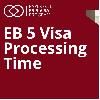How is EB-5 Visa Availability Calculated?
Understanding EB-5 Visa Availability: Calculation, Factors, and Strategic Insightslast updated Saturday, January 10, 2026
#EB-5 visa #eb-5 visa availability
| | by Sidra Jabeen | Content Manager, Paperfree Magazine |

QUICK LINKS
AD
Get Access to EB 5 Investment Visa Resources
The EB-5 visa program offers a pathway to U.S. citizenship through investment. Initiated by the Immigration Act of 1990, this program allows foreign investors to gain a green card by investing a substantial amount in U.S. businesses and creating jobs for American workers. Understanding the nuances of visa availability within this program is crucial for investors aiming to optimize their investment timing and strategy.
For a detailed explanation on reserved and set-aside visas under the EB-5 program, you can read more about it in this comprehensive article on reserved and EB-5 set-aside visas.
Importance of Understanding Visa Availability
The EB-5 visa program, which grants U.S. permanent residency to foreign investors, has a fixed allocation of 7.1% of the total annual employment-based visas, translating to approximately 10,000 EB-5 visas each year. However, the actual number available can fluctuate due to factors such as unused family-based visas from the previous year and per-country limits. To understand how EB-5 visa availability is calculated, it’s essential to look at various factors, including the total visa supply, set-aside categories, and country-specific demand.
Annual Visa Allocation and Employment-Based Quota
The U.S. allocates around 140,000 employment-based visas annually. EB-5 visas, specifically, receive 7.1% of this total, meaning about 10,000 visas each year are reserved for immigrant investors and their families. In addition to this base number, unused visas from the family-based immigration system from the previous fiscal year may be added to the employment-based categories. For example, in FY2024, the total employment-based visa availability rose to 161,000 due to the carryover of unused family-based visas from FY2023.
Set-Aside Categories and TEA Investments
The EB-5 program is divided into several set-aside categories: Unreserved, High Unemployment, Rural, and Infrastructure. Each of these categories has a certain portion of the 10,000 visas allocated. Typically, investors targeting investments in rural or high unemployment areas are prioritized due to U.S. economic development goals. For example, rural TEA (Targeted Employment Area) investments have shown particularly strong demand in recent years.
The August 2024 I-485 report, released by USCIS, showed clear trends in visa demand, especially in the rural TEA category. This data provides a snapshot of investors filing I-526/I-526E petitions and awaiting their visa stage.
Per-Country Caps and the Challenge of Backlogs
One of the most important factors in EB-5 visa availability is the 7% per-country cap. This cap limits the number of visas any one country can receive to approximately 700 per year, including both principal investors and their families. While this system ensures diversity in the immigrant pool, it has created significant backlogs for countries with high demand, particularly China and India.
For instance, China has had a significant backlog since 2014-2015, when over 9,000 Chinese investors contributed at least $500,000 each, hoping to qualify for EB-5 visas. As of 2024, more than 12,000 China-born applicants, with priority dates before July 2016, are still awaiting their EB-5 visas. Similarly, India also faces growing wait times, with over 1,700 applicants from 2019 or earlier waiting for their visas as of mid-2024. The WR Immigration FOIA data published in April 2024 highlights the growing backlog of EB-5 applicants, particularly from China and India.
The Impact of I-526 Processing Times By Country
A significant issue in determining visa availability is the pace of I-526/I-526E petition processing. When I-526 petitions are filed, investors essentially enter the visa pipeline. However, processing delays can extend this pipeline, leading to longer wait times. For example, if I-526E processing remains slow, many investors could be stuck waiting for their visas well beyond FY2025.
In a worst-case scenario, where the entire pipeline of investors filing I-526 up to March 2024 reached the visa stage in FY2025, the demand for high unemployment visas would exceed supply, resulting in backlogs spilling over into FY2026. The Visa Bulletin’s cut-off dates will likely reflect this imbalance. Additionally, if I-526 processing remains slow, fewer applicants may be able to access FY2025 visas, potentially carrying over unused visas to FY2026, further complicating the backlog situation.
Visa Availability for FY2025
For FY2025, the situation becomes more complex due to carryover visas from FY2024. Based on estimates, there could be around 11,000 Unreserved visas available in FY2025, with approximately 770 available for India and more for China depending on ROW (Rest of World) applicants. However, with China’s significant backlog, it’s expected that many applicants from pre-2016 priority dates will still be waiting in FY2026.
Additionally, since country caps are combined with the ROW category, every visa issued to ROW applicants reduces the number available for high-demand countries like China and India. This can lead to further delays in visa issuance for investors from these countries. The backlog is further compounded by the non-FIFO (First In, First Out) processing system, where some investors with later priority dates may receive visas before those with earlier dates.
Book Your Free Consultation with Paperfree EB-5 Visa Experts. Get Personalized Advice and Investment Plans. Book Your Free Consultation Today!

Frequently Asked Questions (FAQs):
What is the annual cap for EB-5 visas?
The EB-5 visa program has an annual cap of approximately 10,000 visas, including visas for investors and their immediate family members.
How does the per-country cap affect EB-5 visa availability?
Each country can only use up to 7% of the total visa cap if additional visas are available from underutilized countries, affecting applicants from high-demand countries like China and India.
What role does the U.S. Department of State play in EB-5 visa distribution?
The Department of State manages the visa allocation process, oversees the Visa Bulletin, and handles the reallocation of unused visas.
How are unused EB-5 visas reallocated each year?
Unused EB-5 visas from countries that do not reach their cap are redistributed to oversubscribed countries, balancing the demand across nationalities.
Can legal changes impact the availability of EB-5 visas?
Yes, legislative reforms or changes in immigration policies can significantly alter visa availability, either restricting or expanding access.
What is the Visa Bulletin, and how does it influence my EB-5 application?
The Visa Bulletin is published monthly by the Department of State and provides updates on which priority dates are currently being processed. This information is crucial for understanding when an application might advance.
What does 'priority date' mean in the context of an EB-5 visa?
A priority date is the date when your visa application is officially filed and accepted, marking your place in the visa queue.
How do reserved visas under the EB-5 program work?
Reserved visas are set aside for specific types of investments, such as those in rural areas or regions with high unemployment, which can lead to faster processing times.
What strategies can help you navigate through country-specific backlogs?
Investing in a project within a reserved visa category or considering alternative immigration pathways are strategies to mitigate delays caused by backlogs.
How can I predict changes in EB-5 visa availability?
Keeping abreast of U.S. immigration policy changes and economic trends and consulting with immigration experts can help forecast shifts in visa availability.
Conclusion
Calculating EB-5 visa availability is a complex process that involves multiple variables: the annual employment-based visa cap, per-country limits, unused family-based visas, set-aside categories, and backlog from high-demand countries. Investors from countries like China and India, which have significant backlogs, face long wait times due to the combined effects of visa allocation rules and processing delays. As we move into FY2025, these backlogs and demand patterns will continue to shape the landscape of EB-5 visa issuance. Understanding these trends and keeping an eye on visa bulletins and processing times will be crucial for future EB-5 investors.
Pages Related to #EB-5 visa
- Benefits of commercial hard money loans

- EB5 Investment Visa Guide 2025

- Paperfree Investment Visa EB-5 Program is Your Your Clear Path to Green Card USA

- US Immigration: Big increase in EB–5 visa fees proposed

- EB 5 Visa Requirements 2024, A Guide To on eligibility for U.S. Investment-Based Residency

- EB5 Processing Time: A Journey Towards Green Card 2026 | Paperfree.com

- July 2025 Visa Bulletin: EB-5 Investment Visa Program Shows Positive Movement

- EB-5 processing time by country updated 2026

Popular Page
Benefits of the EB-5 Visa Program| A Comprehensive Guide
Book a Free Complimentary Call
real estate investing Investment Visa USA Investment Magazine Private Real Estate Funds real estate funds
